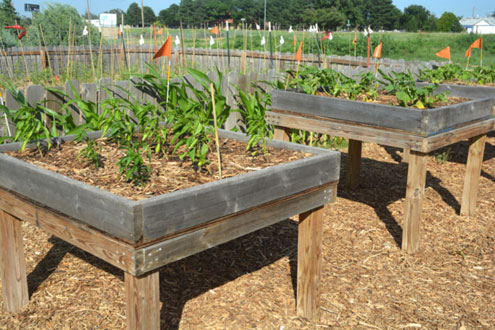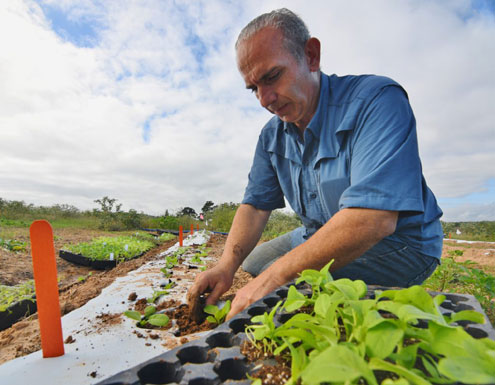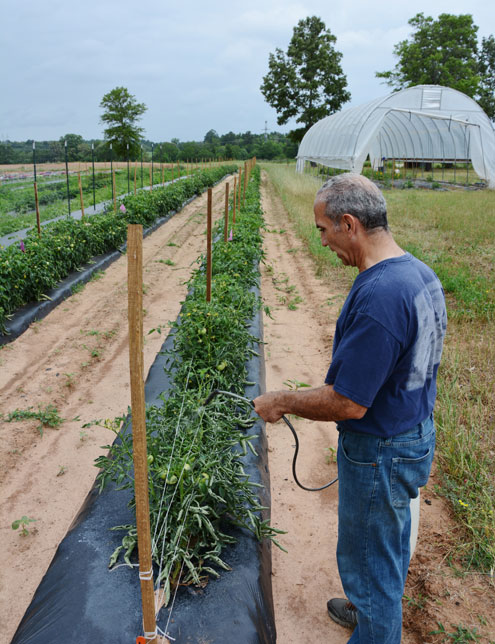Here's a quick-build setup and tips to get started
Interest in starting a home vegetable garden has been spurred on by food scarcity or uncertainty related to the ongoing COVID-19 pandemic.
Whether you’re a beginning gardener or someone who has planted vegetables in the past, now is the time to be planting, said a Texas A&M AgriLife Extension Service vegetable specialist.
Joe Masabni, Ph.D., AgriLife Extension vegetable specialist, Dallas, has an easy setup for gardeners to build and plant a vegetable garden in a day. He also has easy-to-follow tips for beginners to protect and provide for plants.
“This is what I would tell anyone who came to me and said, ‘Joe, I need to plant a garden quickly and without worrying about home vegetable garden theory and things like soil tests,’” he said. “Anyone could have this setup planted and ready to go in a day. But the gardening part takes a commitment to the plants if you want to be successful.”
Raised beds
Pick an area that gets a good amount of sun, he said. Full sun, or morning sun and some afternoon shade are best.
Start by building raised beds, Masabni said. They can be framed out using treated or untreated lumber, but he prefers using concrete cinder blocks because they last and are fastest to build.
Lay a block on their sides with the holes facing down and place another on top. You’re effectively building a wall to hold your garden. The height of two blocks will provide room for good root growth.

Fill the area inside the blocks with compost or a 50/50 compost and sand combination, he said.
“You’ll need a large amount, a 4-foot by 8-foot by 16-inch deep (height of two cinder blocks) needs about 1.5 yards. So, look for a local facility that sells in bulk,” he said. “If they do a 50/50 mix, that’s great, or you can till it together. Compost or a pre-mixed compost-sand combo is quickest.”
Vegetable variety selection
You’ll want to select vegetable varieties suitable for the region, preferably easy to grow and suited for our climate, that are productive and nutritious, Masabni said. Squash, okra, tomatoes, peppers, eggplant, cucumbers, potatoes, onions and garlic provide a good range of growing options.
Masabni said there are AgriLife Extension resources available, including publications and recorded webinars, that provide a wide range of information about specific vegetables.
The Aggie Horticulture webpage provides a variety of extension publications tailored for the homeowners. Those interested in additional details about vegetables can reference the Commercial Production Guides.

“Aggie Horticulture webpage also has a link to help you determine which varieties are best suited for your location,” he said. “Plant what you want and what you will eat. Experiment with varieties all you want, but understand Texas is big, and we recommend certain varieties for certain locations based on research.”
Be ready to fight for your veggies
Consider plants as family, Masabni said, and people don’t want their family to get sick.
“Be prepared to fight insect pests and diseases,” he said. “Whether you want to go organic or with traditional chemical treatments is a matter of personal preference. But be ready to spray because it’s only a matter of time before pests and diseases try to move in.”
So, buy a quality backpack sprayer and at least three fungicides and three insecticides. Masabni uses organic fungicides and insecticides. Organic fungicides that have worked for him include Serenade, Actinovate or a Bordeaux mixture of copper, lime and water.
Masabni recommends Spinosad, Bt or any horticultural oil as organic insecticides. Fungicides and insecticides can be mixed and applied at the same time, he said.
Apply sprays to transplants upon planting or seedlings once they’ve emerged, Masabni said. Spray plants with the mix every 7-14 days depending on the weather.
“If the spring is rainy, then spray every 7 days,” he said. “If it’s a dry spring, then spray every 14 days.”

Having and using a variety of fungicides and pesticides will decrease bugs’ ability to build up resistance to any one treatment, he said. So, switch up the fungicide/pesticide mix every few weeks.
Washing vegetables with some warm water or soapy water will remove any residue left from organic or traditional sprays following harvest, he said.
“You have to spray something if you want a crop,” he said. “During my research trials, I yielded 10% of the potential crop from plants that didn’t receive any spray treatments.”
Provide food and water
Fertilizer feeds the plant, and water is essential for all life, including plants, Masabni said.
“How much water is never an easy answer because the factors change as plants grow and environmental conditions like temperature change,” he said. “It’s learned with experience. But I will say ignore the appearance of the soil surface and focus on the soil 4 inches deep because that is where the roots of mature plants are.”
Masabni recommends investing in a soil probe to see if the soil at 4 inches is wet, moist or dry.
When it comes to fertilizer, going organic or with chemical nitrates is a personal preference, he said. Plants don’t care whether the nitrate source is chicken litter, organic Chilean nitrate or 10-10-10, which provides 10% each of nutrients nitrogen, potassium and phosphorous.
Slow release fertilizers or 1 pound of chicken litter is enough to start a 4-foot by 8-foot garden. But he recommends a water-soluble fertilizer every 2-3 weeks throughout the season.
The secret is no secret
Masabni said growing vegetables requires effort and vigilance, but it shouldn’t feel like work. It just takes providing and protecting the plants so they can return the favor and provide for you at harvest time.
“The secret to successful vegetable gardening is your shadow in the garden,” he said. “Being in the garden every day to see the first bug and squash it or to remove the first dead leaf or to water at the right time is the secret. It’s catching problems early and dealing with them immediately that leads to successful gardening.”